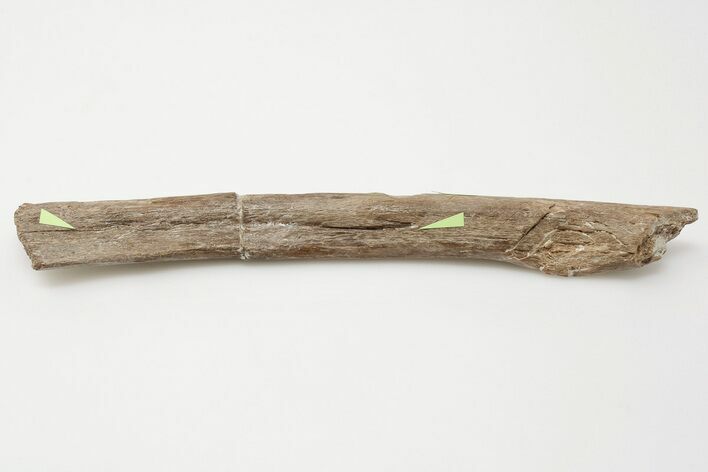This Specimen has been sold.
6.8" Mosasaur Rib Section with Shark Bite Marks! - Kansas
This is a killer 6.8" long, rib section of the Mosasaur, Platecarpus coryphaeus. It comes from the Late Cretaceous, Smoky Hill Chalk in Gove County, Kansas. The bone preservation on the rib is amazing, but what really sets this specimen apart are the multiple bite marks. Shark bite marks. These bites appear as a long gashes and crushed indentations on various faces of the rib. The restoration is minimal and any repaired cracks were expertly stabilized. This awesome specimen shouldn't be overlooked.
Platecarpus is an extinct aquatic lizard belonging to the mosasaur family. Fossils have been found in the United States as well as possible specimens in Belgium and Africa. It reached lengths of up to 14 feet long: half of that length was its tail alone. Platecarpus probably fed on fish, squid, and ammonites. Like other mosasaurs, it was initially thought to have swum in an eel-like fashion, though a recent study suggests that it swam more like modern sharks.
The genus attracted media attention in 2000, when a specimen unearthed in 1993 in South Dakota, United States, was interpreted as including a fossilized heart. There was much discussion over whether the remains were of a heart. Many scientists now doubt the identification of the object and the implications of such an identification.
Platecarpus is an extinct aquatic lizard belonging to the mosasaur family. Fossils have been found in the United States as well as possible specimens in Belgium and Africa. It reached lengths of up to 14 feet long: half of that length was its tail alone. Platecarpus probably fed on fish, squid, and ammonites. Like other mosasaurs, it was initially thought to have swum in an eel-like fashion, though a recent study suggests that it swam more like modern sharks.
The genus attracted media attention in 2000, when a specimen unearthed in 1993 in South Dakota, United States, was interpreted as including a fossilized heart. There was much discussion over whether the remains were of a heart. Many scientists now doubt the identification of the object and the implications of such an identification.
The Smoky Hill Chalk Member of the Niobrara Chalk formation is a Cretaceous conservation Lagerstätte, or fossil-rich geological formation, known primarily for its exceptionally well-preserved marine reptiles. It outcrops in parts of northwest Kansas--its most famous localities for fossils--and in southeastern Nebraska. Large, well-known fossils excavated from the Smoky Hill Chalk include marine reptiles such as plesiosaurs, large bony fish such as Xiphactinus, mosasaurs, pterosaurs, and turtles.
SPECIES
Platecarpus coryphaeus
LOCATION
Gove County, Kansas
FORMATION
Niobrara Formation
SIZE
6.8" long
CATEGORY
SUB CATEGORY
ITEM
#197825
We guarantee the authenticity of all of our specimens.
 Reviews
Reviews


















